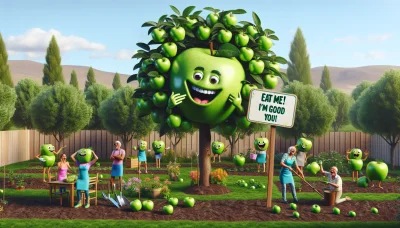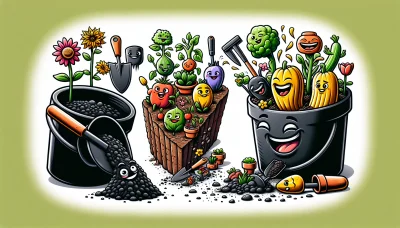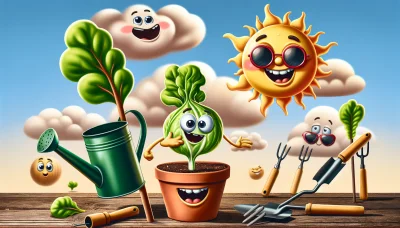How to eat guava Quiz
Test Your Knowledge
Question of
How to Eat Guava: A Gardener's Guide
Guava is not only a delicious tropical fruit but also a powerhouse of nutrients, making it a valuable addition to any garden. Rich in vitamins C and A, fiber, and antioxidants, guava offers numerous health benefits, including boosting the immune system and improving heart health. For gardeners, growing guava adds a lush, leafy green aesthetic to the garden space, and the satisfaction of harvesting your own fruit is unmatched. Its significance in gardening extends beyond its nutritional value, as it can also play a role in natural pest control, thanks to its aromatic leaves.
Selecting the Perfect Guava
Choosing the right guava, whether from your backyard garden or the local store, can significantly enhance your culinary experience. A ripe guava is usually a sign of sweetness and flavor, making it essential to pick the best. The first indicator of ripeness is the color. Look for guavas that have turned from green to a light yellow or even a slight pinkish hue. This color change is a good sign that the guava is ready to eat. However, color alone can be deceiving, so it's important to also consider the texture. A ripe guava should yield slightly under gentle pressure, similar to an avocado. It should not be too soft, which could indicate overripeness, nor too hard, as it may not be ready to eat. Lastly, the aroma is a powerful indicator of ripeness. A ripe guava emits a sweet, fragrant scent that is hard to miss. If you can smell the sweetness without even cutting into the fruit, it's likely at its peak of ripeness. Combining these three indicators—color, texture, and aroma—will help you select the perfect guava for your next dish or snack.
Preparation and Serving Methods
Steps to Wash, Cut, and Prepare Guava
- Start by washing the guava under cold running water to remove any dirt or pesticides.
- Dry the guava with a clean cloth or paper towel.
- Using a sharp knife, cut the guava into halves or quarters, depending on your preference.
- Remove the seeds with a spoon if you find them too hard or if you prefer a smoother texture.
- Once cut, the guava can be eaten as is, with the skin or peeled, depending on your taste.
Different Ways to Serve Guava
- Raw: Simply slice or quarter the guava and enjoy its fresh, sweet, and slightly tart flavor.
- In Salads: Add chopped guava to fruit or green salads for a tropical twist. It pairs well with ingredients like avocado, citrus fruits, and leafy greens.
- As a Juice: Blend guava with water and strain it to make a refreshing juice. You can add sweeteners or other fruits to enhance the flavor.
- Guava Smoothie: Combine guava with yogurt and other fruits like bananas or strawberries for a nutritious smoothie.
- Guava Jam: Cook guava with sugar and pectin to make a delicious homemade jam.
The Nutritional Value of Guava
| Nutrient | Amount per 100g |
|---|---|
| Energy | 68 kcal |
| Protein | 2.55 g |
| Total Fat | 0.95 g |
| Carbohydrates | 14.32 g |
| Dietary Fiber | 5.4 g |
| Sugars | 8.92 g |
| Vitamin C | 228.3 mg |
| Vitamin A | 624 IU |
| Calcium | 18 mg |
| Iron | 0.26 mg |
Growing Guava in Your Garden
Guava trees are a tropical delight that can bring a taste of the exotic to your garden. Planting guava trees involves selecting a sunny spot with well-draining soil. It's important to water your guava tree regularly, especially during the dry season, but be careful not to over-water as guava trees are susceptible to root rot. Fertilize your guava tree during the growing season to ensure a bounty of fruit. Pruning is also crucial to remove any dead branches and to encourage healthy growth.
The best climate for guava cultivation is tropical to subtropical, with temperatures ranging from 68°F to 82°F. Although guava trees can tolerate a short period of cold down to about 27°F, they thrive in warm conditions. If you live in a cooler climate, growing guava in pots that can be moved indoors during colder months is an option. With proper care and the right climate conditions, your guava tree will be a fruitful addition to your garden.
Common Pests and Diseases Affecting Guava Trees
- Fruit Flies : These pests lay eggs on the guava fruit, leading to maggot infestation. To prevent fruit flies, use insect nets to cover trees or set up fruit fly traps around the garden. For treatment, remove and destroy infested fruits to reduce the population.
- Guava Moth : The larvae of the guava moth feed on the fruit, causing damage. Prevention includes using pheromone traps to catch adult moths. Infested fruits should be picked off and destroyed to control their spread.
- Anthracnose : This fungal disease causes dark, sunken lesions on fruits and foliage. To prevent anthracnose, ensure good air circulation by pruning and avoid overhead watering. Treat infected plants with fungicides recommended for anthracnose and remove any affected parts of the plant.
- Guava Wilt Disease : Caused by a fungus, it leads to wilting and death of the tree. Prevention involves planting resistant varieties and ensuring proper drainage. Infected trees should be removed and destroyed to prevent the spread of the disease.
- Root-Knot Nematodes : These microscopic worms attack guava roots, causing swellings or knots. To prevent nematodes, practice crop rotation and use nematode-resistant varieties. Infected trees may need to be treated with nematicides or removed to prevent spread to healthy trees.
FAQs About Eating and Growing Guava
Guavas are a tropical fruit enjoyed by many for their unique flavor and health benefits. There are several varieties of guava, including the common guava, strawberry guava, and lemon guava, each with its own distinct taste and texture. The best time to harvest guava is when they become slightly soft and give off a fragrant aroma, indicating they are ripe and ready to eat. Incorporating guava into your diet can be as simple as eating the fruit by itself or adding it to salads, smoothies, or desserts for a tropical twist. Guava is also rich in vitamins and antioxidants, making it a nutritious addition to your meals.












